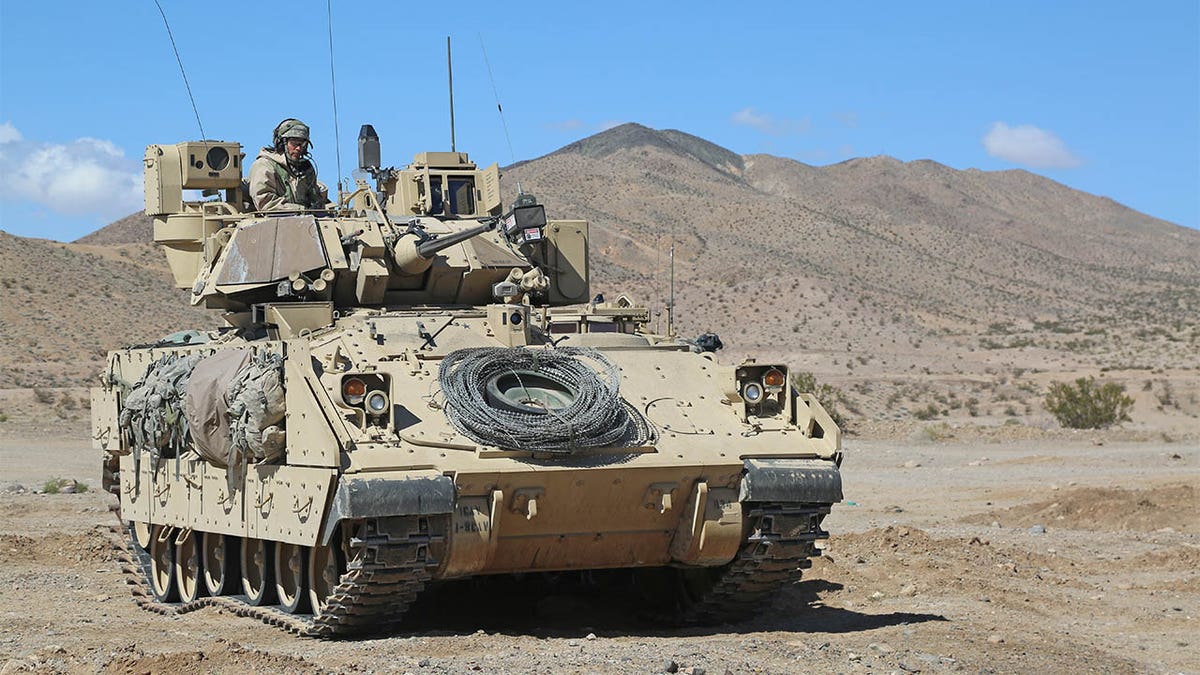Fox News Flash top headlines for October 21
Fox News Flash top headlines are here. Check out what's clicking on FoxNews.com.
Robot armies on attack, self-driving tanks, long-range, computer-enabled sensors and natural camouflage technology are just a few of the many factors expected to characterize warfare in 2035, a set of circumstances now under close and careful examination by teams of Army scientists looking to anticipate the wars of tomorrow.
“Our core focus areas include AI, robotics and autonomy underpinned by network and data technologies,” Col. Stephanie Ahern, Secretary of the Army Initiatives Group Chief, told reporters Oct. 14.
The effort, called “Team Ignite,” is lodged within Army Futures Command. It is a collaborative endeavor involving scientists, engineers, academics, concepts experts and weapons requirements writers to explore the realm of the possible in terms of research, emerging technologies, maneuver formations and new tactics, techniques and procedures.
“We have a good view of the future operating environment and are refining our understanding of what it will be in 2035 and beyond. There are some general characteristics of things that will pose challenges to the way we operate. At the classified level, we are looking at threat levels and the evolution of those threats over time. Gen. Murray (Gen. John Murray, Army Futures Command) started a series of future threat deep dives to see very specific threats into the future. We focus on an understanding of where we are with technologies and are conducting dive reviews of 17 technology areas with partners from other services,” Maj. Gen. John A. George, Commander, Combat Capabilities Development Command, Army Futures Command, told reporters at the 2020 Association of the United States Army Annual Symposium.
Other areas of focus include research related to synthetic materials, biological phenomena and naturally occurring substances such as an organic material that can be used for camouflage because of how it filters light, Dr. Jean Vettel, Chief Scientist for Futures & Concepts Center and Ignite Senior Science Lead, told reporters.
'ATTACKING AT SPEED': ARMY PROJECT CONVERGENCE AND BREAKTHROUGH LIGHTNING-FAST WAR
Should the application of these synthetic materials come to fruition, they could help soldiers and combat units avoid detection from enemy sensors and satellites.

U.S. Army Soldiers from Bravo Company, 1st Battalion, 8th Cavalry Regiment, 2nd Brigade Combat Team, 1st Cavalry Division, provide security around a local town during Decisive Action Rotation 15-05 at the National Training Center in Fort Irwin, Calif., March 3, 2015. Decisive Action Rotations are geared toward an adaptive enemy in a complex environment. (U.S. Army photo by Sgt. Charles Probst/Released)
“We move into the experimentation phase to make data-informed decisions about moving forward with the most promising technology for the Army to maximize operational advantage,” Vettel said.
Earlier this year, Gen. Murray told The National Interest that new weapons and technology not only change attack methodologies, but also inspire large tactical adaptations to maneuver formations and combat operations.
“Experimentation is just as important as the technology is understanding what this will do in terms of what formations will look like in the future and how they will be employed. What is the greatest value from a reconnaissance standpoint or a weapons standpoint and the linkages between them,” Murray said.
"Concept writers and scientists are sitting together penciling in how we might want to fight in the future, to make the right links between the concepts, requirements and technologies,” George said.
NEW AIR FORCE STEALTH BOMBER ARRIVES IN JUST '2 YEARS'
The idea is to get a multi-decade jump on warfare decades from now, involving a carefully calibrated blend of intelligence information, near-term emerging weapons, basic research looking 20 years ahead and new technical trends promising to massively alter the nature of war.
“If we write the concept and say ‘if only I could?’ ... And then say ‘well I can’t do that right now, but what about in 15 years?’ There is a path to get there if we put the dollars in the right place today,” Murray said. “We are making those investments now, so that 15 years from now … we go from ‘if only I could to … we actually can.”
It’s called a “wet gap crossing,” the point wherein armored forces, infantry and tactical vehicles need to cross a body of water such as a river while on attack. This naturally occurring circumstance, often encountered in combat, not only causes logistical challenges for maneuvering forces but also increases vulnerability to enemy attack.
How quickly could a mechanized unit build a bridge? What if a known route had to be abandoned due to changing threat circumstances, requiring units to traverse water?
"Getting units over rivers is a very dangerous operation because you are exposed. We can use robotics and have launched a focused excursion looking at robotic air assault drones,” Ahern said.
The challenges, Ahern continued, include ensuring that forces and platforms can survive the landings, sustain movements, protect dismounted units and ensure safe passage for follow on forces.
CLICK HERE TO GET THE FOX NEWS APP
“We examined robotic air assault drones with the 101st Airborne units to assess what were some of the attributes we would need. We are incorporating those lessons into an understanding of how we will operate into the future,” said Dr. Jean Vettel, Chief Scientist for Futures & Concepts Center and Ignite Senior Science Lead.
-- Kris Osborn is the Managing Editor of Warrior Maven and The Defense Editor of The National Interest --

